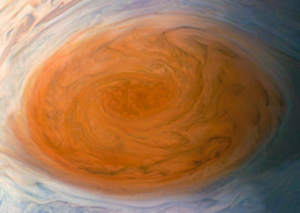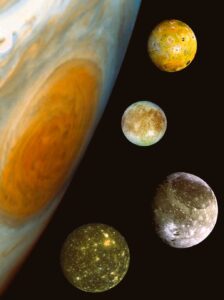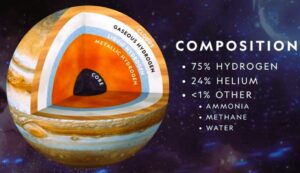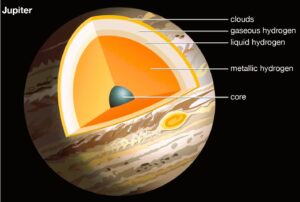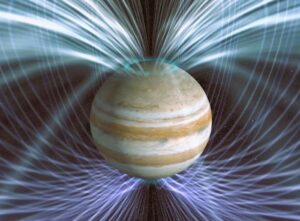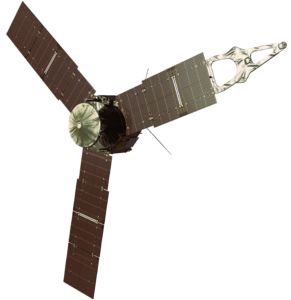- abaashishb7
- April 6, 2024
- 10:53 am
- No Comments
Jupiter Planet
गुरू (बृहस्पति) ग्रह
* Jupiter : A Majestic World Of Mystery and Power
आपल्या सौरमालेतील सर्वात मोठा ग्रह, गुरू हा एक वायू राक्षस आहे जो त्याच्या प्रचंड आकारमानासाठी,
आकर्षक स्वरूपासाठी आणि गतिमान वैशिष्ट्यांसाठी ओळखला जातो. रोमन देवतांच्या राजाचे नाव
असलेल्या, ज्युपिटरने शतकानुशतके खगोलशास्त्रज्ञ आणि स्टारगेझर्सचे आकर्षण मिळवले आहे. त्याच्या
आकर्षक असणाऱ्या ढगांपासून ते त्याच्या आयकॉनिक ग्रेट रेड स्पॉटपर्यंत, ज्युपिटर आपल्या रात्रीच्या
आकाशात एक चित्तथरारक देखावा सादर करतो.
* Discovery Of Jupiter
Jupiter, the largest and most massive planet in our solar system, has a history of
discovery that dates back thousands of years. Here, we delve into the fascinating
journey of how this colossal gas giant was first observed and understood by ancient
civilizations, leading to modern-day exploration and revelations.
Ancient Observations
The discovery of this planet can be traced back to ancient times when early astronomers
observed bright points of light moving against the backdrop of fixed stars. These
“wandering stars,” or planets as we know them today, were seen in the night sky,
including the majestic this planet.
Mesopotamian Records
Around the 7th century BCE, Babylonian astronomers meticulously recorded the
movements of celestial objects, including This Planet. They named it after their king of
gods, Marduk, noting its regular patterns against the stars.
Greek Recognition
In ancient Greece, Jupiter was associated with Zeus, the ruler of Olympus. Greek
astronomers such as Ptolemy further studied its movements, contributing to the
understanding of its retrograde motion—an apparent reversal in its path as seen from
Earth.
Galileo’s Telescope
A significant milestone in Jupiter’s discovery occurred in 1610 when Galileo Galilei turned
his newly crafted telescope to the night sky. Through his crude but revolutionary
telescope, Galileo observed four bright points of light orbiting Jupiter. These were later
identified as the Galilean moons – Io, Europa, Ganymede, and Callisto. This discovery
shattered the notion that everything in the cosmos orbited around Earth, forever changing
our view of the universe.
The Great Red Spot
Jupiter’s most iconic feature, the Great Red Spot, was first observed in the 17th century.
It is a massive storm, larger than Earth, swirling in the planet’s atmosphere. This
colossal tempest has captured the imaginations of astronomers for centuries, becoming
a symbol of Jupiter’s dynamic and ever-changing nature.
Modern Exploration
As technology advanced, so did our exploration of Jupiter. In the 20th century,
spacecraft such as Pioneer and Voyager missions provided humanity with close-up
views of the gas giant, revealing its intricate cloud patterns, intense magnetic fields, and
diverse moons.
Juno’s Arrival – One of the most recent and significant missions to Jupiter is NASA’s Juno
spacecraft, which arrived at the planet in 2016. Juno’s mission is to study Jupiter’s
composition, gravity, magnetic fields, and polar regions, shedding light on its formation
and evolution.
* Dimension of Jupiter
Diameter
1:- Equatorial Diameter: Jupiter’s equatorial diameter measures approximately 142,984
kilometers (88,846 miles). This makes it more than 11 times wider than Earth.
2:- Polar Diameter: The polar diameter of this planet is slightly smaller than its
equatorial diameter, measuring around 133,709 kilometers (83,082 miles). This
variation is due to the planet’s rapid rotation, which causes a slight flattening at the
poles.
Circumference
1:- Equatorial Circumference: With its equatorial diameter, This Planet’s circumference
at the equator is about 439,264 kilometers (273,472 miles). This immense size
means it would take more than 11 Earths lined up next to each other to span This
Planet’s equator.
2:- Polar Circumference: The polar circumference of This Planet is slightly smaller,
measuring approximately 419,970 kilometers (261,854 miles).
Volume
Calculating the volume of a gas giant like Jupiter is a bit more complex due to
its gaseous nature. However, it is estimated that planet’s volume is about
1.4313 x 10^15 cubic kilometers (3.4313 x 10^14 cubic miles). This means you could fit
over 1,300 Earths inside This Planet!
Mass
Jupiter’s massive size also translates to an incredible mass. The planet has a
mass of approximately 1.898 x 10^27 kilograms (4.185 x 10^27 pounds). To put this into
perspective, This Planet’s mass is over 300 times that of Earth!
Surface Area
Calculating the surface area of a gas giant is challenging due to its lack of
a defined solid surface. However, if we consider the “surface” where the atmosphere
becomes dense enough for pressure to be similar to Earth’s sea level pressure, This
Planet’s surface area is estimated to be about 6.14 x 10^10 square kilometers (2.37 x
10^10 square miles).
Notable Features
1:- Great Red Spot: This iconic storm on Jupiter is so large that it could engulf multiple
Earths. Its dimensions are ever-changing, but at its largest, it has been estimated to
be about three times the diameter of Earth.
2:- Galilean Moons: This Planet is orbited by a fascinating array of moons, the largest of
which are the Galilean moons – Io, Europa, Ganymede, and Callisto. Ganymede, the
largest moon in our solar system, is even larger than the planet Mercury.

* Key Fact of Jupiter
Distance from the Sun
1:- Average Distance: Approximately 778 million kilometers (483.8 million miles)
2:- Perihelion (Closest Approach to Sun): About 741 million kilometers
(460.5 million miles)
3:- Aphelion (Farthest Distance from Sun): Around 816 million kilometers
(507.1 million miles)
Orbital Period (Year)
This Planet takes about 11.86 Earth years to complete one orbit around the Sun.
1:- Day Length: This Planet’s rapid rotation means it has a short day compared to its
orbital period. A day on Jupiter (one full rotation on its axis) lasts about
9.9 Earth hours.
2:- Size: Diameter: Approximately 139,822 kilometers (86,881 miles)
This Planet is so large that it could fit more than 1,300 Earths inside it.
3:- Gravity: Surface Gravity: About 24.79 m/s² (equivalent to 2.53 times Earth’s gravity)
This strong gravity is due to this planet’s massive size and mass.
Appearance
This Planet is known for its distinctive bands of clouds and its Great Red Spot.
1:- Bands: Jupiter’s atmosphere has alternating light and dark bands caused by powerful
jet streams.
2:- Great Red Spot: A massive storm that has been observed for centuries, larger than
Earth.
Surface Features
This Planet, being a gas giant, doesn’t have a solid surface like terrestrial planets.
Any “surface” is a transition zone between the gas atmosphere and a possible liquid or
ice interior.
Some features like the Great Red Spot are visible from Earth, but they are part of the
atmosphere, not the solid ground.
Atmosphere
1:- Composition: This Planet’s atmosphere is primarily hydrogen (about 75%) and helium
(about 24%), similar to the composition of the Sun. Other components include traces
of methane, ammonia, water vapor, and other compounds.
2:- Cloud Layers: The different cloud layers in this planet’s atmosphere are made of
ammonia crystals, sulfur, and mixtures of these chemicals.
3:- Storms: Besides the Great Red Spot, This Planet experiences intense storms and
cyclones, including lightning discharges that are the strongest in the solar system.
Moons
This Planet has a vast system of over 80 known moons. The four largest moons, known
as the Galilean moons, are
1:- Io: Known for its volcanoes and colorful surface.
2:- Europa: Has a subsurface ocean beneath an icy crust, making it an intriguing target
for astrobiology.
3:- Ganymede: The largest moon in the solar system, larger than Mercury, and has its
own magnetic field.
4:- Callisto: Heavily cratered with a relatively ancient and unchanged surface.
* Composition Of Jupiter
The composition of Jupiter’s atmosphere is primarily hydrogen and helium, similar to the
composition of the Sun. Here’s a more detailed breakdown
1:- Hydrogen (H2):
This Planet’s atmosphere is mainly composed of molecular hydrogen (H2), making
up about 75% of its composition by mass.
2:- Helium (He):
The next most abundant element in This Planet’s atmosphere is helium, making up
about 24% of the composition.
Other Gases
3:- Methane (CH4): This Planet’s atmosphere also contains small amounts of methane,
which contributes to its reddish-brown coloration.
4:- Ammonia (NH3): Ammonia is another trace gas found in this planet’s atmosphere,
forming clouds of white and brown hues.
5:- Water Vapor (H2O): Water vapor is present in small amounts, contributing to the
planet’s weather systems and cloud formations.
6:- Hydrogen Sulfide (H2S): This gas is believed to be present in this planet’s upper
atmosphere, contributing to its coloration and chemistry.
7:- Other Trace Gases: There are also traces of other compounds such as phosphine
(PH3), ethane (C2H6), and others in this planet’s atmosphere.
The exact ratios and concentrations of these gases can vary with altitude in This
Planet’s atmosphere. Deeper within the planet, under the high pressures and
temperatures, it’s believed that hydrogen transitions into a metallic state, forming a
liquid metallic hydrogen layer that surrounds a rocky core. This unique state of hydrogen
is responsible for this planet’s incredibly strong magnetic field.
* Structure Of Jupiter
Core
The core of This Planet is thought to be a relatively small and dense region, composed
primarily of heavier elements.
It is estimated to have a mass of about 10-20 times that of Earth.
The core likely consists of rock, metals, and hydrogen compounds under extreme
pressure and temperature.
The exact size and composition of This Planet’s core are not precisely known and are the
subject of ongoing research and modeling.
Metallic Hydrogen Layer
Above the core, there is a layer of metallic hydrogen, which is hydrogen that has been
compressed to the point where it behaves like a metal.
This layer is believed to be quite thick and extends outward from the core.
The immense pressure within This Planet, created by its gravity, causes the hydrogen to
transition to this unusual state.
Liquid Hydrogen Layer
Surrounding the metallic hydrogen layer is a region of liquid hydrogen.
This layer is thought to be in a supercritical state, meaning it behaves like both a liquid
and a gas due to the extreme pressure.
The liquid hydrogen layer makes up a significant portion of This Planet’s interior.
Molecular Hydrogen Layer
Above the liquid hydrogen layer, there is a layer of molecular hydrogen gas.
This layer gradually transitions into This Planet’s visible atmosphere.
The molecular hydrogen layer extends upward into the atmosphere, becoming less
dense and transitioning into the upper layers of clouds.
* What Would Happen if a Human Were to Enter Jupiter
Descent through the Atmosphere
As a human descends into This Planet’s atmosphere, they would encounter immense
pressures.
Jupiter’s atmospheric pressure increases rapidly with depth, reaching pressures of
over 100,000 times Earth’s atmospheric pressure at sea level.
This extreme pressure would crush the human body almost instantly. It would be similar
to being crushed by the pressure of an ocean many kilometers deep.
1:- Heat: This Planet’s atmosphere is also incredibly hot, with temperatures increasing
the deeper you go. Near the top of the atmosphere, temperatures can reach around
-145 degrees Celsius (-234 degrees Fahrenheit).
However, as you descend, the temperature rises due to the heat generated by Jupiter’s
interior. Eventually, the heat would become intense enough to vaporize and
then incinerate the human body.
2:- Chemical Composition: Jupiter’s atmosphere is primarily composed of hydrogen
and helium, with trace amounts of other gases like methane and ammonia.
The lack of oxygen would mean that a human could not breathe in s
atmosphere. Without a suit supplying oxygen, the person would quickly suffocate.
3:- Wind and Turbulence: Jupiter has incredibly strong winds and turbulent weather
systems.Wind speeds can exceed 400 mph (650 km/h) in Jupiter’s atmosphere.
These powerful winds would likely tear apart any human-sized object long before
reaching deeper layers.
4:- Physical Disintegration: Due to the extreme pressures and temperatures, a human
body would not survive intact. It would likely be crushed, incinerated, and torn apart
by the intense forces long before reaching any solid surface (if there even is one).
No Solid Surface: This Planet is a gas giant without a solid surface like the terrestrial
planets. Its “surface” is a transition zone where the atmosphere becomes denser and
turns into a liquid. There is no solid ground to stand on or land upon.
In summary, if a human were somehow able to enter This Planet’s atmosphere, they
would be crushed, burned, suffocated, and torn apart by the extreme conditions long
before reaching any solid “surface” that This Planet might have. It’s a lethal combination
of intense pressure, heat, lack of breathable air, and violent weather that makes This
Planet completely inhospitable to humans.
* Unique Characteristics
Great Red Spot
This Planet is known for its massive storm called the Great Red Spot.
It is an enormous swirling storm that has been raging for at least 400 years.
The Great Red Spot is so large that multiple Earths could fit inside it.
It’s a high-pressure region with winds reaching speeds of about 400 mph (640 km/h).
Strongest Magnetic Field
This Planet boasts the strongest magnetic field of any planet in our solar system,
except for the Sun.
This powerful magnetic field creates intense radiation belts around the planet.
The magnetic field is about 14 times stronger than Earth’s.
Rapid Rotation
This Planet is a fast spinner, completing a full rotation on its axis in about 10 hours.
This rapid rotation causes the planet to flatten slightly at the poles and bulge at the
equator. It also results in strong jet streams and bands in its atmosphere.
Galilean Moons
This Planet has a large and diverse system of moons, but its four largest moons are
known as the Galilean moons: Io, Europa, Ganymede, and Callisto.
These moons were discovered by Galileo Galilei in 1610 and were the first objects found
to be orbiting another planet.
Each of these moons has unique features:
Io: Known for its active volcanoes and colorful surface.
Europa: Has a subsurface ocean beneath an icy crust, making it a target for
astrobiological studies.
Ganymede: The largest moon in the solar system, with its own magnetic field.
Callisto: Heavily cratered and considered one of the most heavily cratered objects in the
solar system.
Ring System
While not as prominent as Saturn’s rings, This Planet does have a faint ring system.
These rings are composed of dust particles, and they were first discovered by the
Voyager 1 spacecraft in 1979.
The main ring is called the “Main Ring,” and it is about 6,200 miles (10,000 kilometers)
wide.
Variable Atmosphere
This Planet’s atmosphere is dynamic and ever-changing, with distinct bands and zones
caused by powerful jet streams.
The alternating light and dark bands are due to differences in temperature and
composition.
This Planet’s clouds are made of ammonia crystals, sulfur, and mixtures of other
chemicals.
Huge Size
This Planet is the largest planet in our solar system, with a diameter of about 139,822
kilometers (86,881 miles).
It is more than 11 times wider than Earth and could fit over 1,300 Earths inside it.
Despite its size, This Planet is not a solid planet; it’s a gas giant composed mostly of
hydrogen and helium.
* Modern Discoveries and Exploration
Juno Mission (NASA)
Launched in 2011, the Juno spacecraft arrived at This Planet in 2016 and has been
orbiting the planet since.
Juno’s mission is to study This Planet’s composition, gravity field, magnetic field, and
polar magnetosphere.
Discoveries from Juno include: Detailed mapping of This Planet’s magnetic field,
revealing a complex and asymmetrical structure.
Mapping of Jupiter’s gravitational field, which provided insights into its interior
structure. Measurements of water abundance in This Planet’s atmosphere, suggesting
that the planet formed farther from the Sun than previously thought.
Great Cold Spot
In 2017, astronomers discovered a massive “cold spot” in Jupiter’s atmosphere
using the Very Large Telescope in Chile.
This cold spot is a large, persistent feature in Jupiter’s upper atmosphere, similar to
the Great Red Spot but colder.
It is caused by a giant cyclone in Jupiter’s atmosphere and is about 24,000
kilometers (15,000 miles) wide.
Galilean Moons
Ongoing studies of Jupiter’s four largest moons (Io, Europa, Ganymede, and Callisto)
continue to reveal new and exciting findings.
Europa: In 2022, NASA’s Hubble Space Telescope detected water vapor erupting from
Europa’s surface, reinforcing the idea of a subsurface ocean.
Ganymede: Recent studies suggest that Ganymede’s magnetic field changes in response
to Jupiter’s magnetic field, indicating a complex interaction between the moon and
its parent planet.
Atmospheric Studies
Advancements in ground-based telescopes and space-based observatories have
allowed for detailed studies of Jupiter’s atmosphere.
Observations have revealed the dynamics of Jupiter’s cloud bands, storms, and
atmospheric phenomena.
Scientists have detected changes in cloud patterns and the appearance of new storms,
providing a deeper understanding of Jupiter’s weather systems.
This Planet’s Auroras
Auroras at This Planet’s poles have been studied extensively, revealing similarities and
differences with Earth’s auroras.
Observations by the Hubble Space Telescope and the Juno spacecraft have provided
insights into the processes that generate Jupiter’s auroras.
Impact Events
Jupiter’s immense gravity makes it a “cosmic vacuum cleaner,” attracting comets
and asteroids. Observations by amateur astronomers and space telescopes have
recorded multiple impact events on Jupiter’s atmosphere.
In 2016, an amateur astronomer in Austria captured footage of a bright flash on This
Planet, likely caused by an asteroid or comet impact.
Mapping and Imaging
Advances in imaging technology have allowed for detailed mapping and monitoring of
Jupiter’s surface and atmosphere.
High-resolution images from spacecraft like Juno and the Hubble Space Telescope have
provided stunning views of This Planet’s storms, clouds, and features.
- abaashishb7
- April 6, 2024
- 10:53 am
- No Comments




